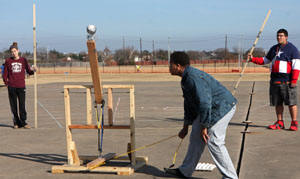Garland ISD is joining hundreds of school districts nationwide by implementing the innovative educational framework known as STEAM, which stands for science, technology, engineering, arts and mathematics. Championed by educators, public officials and researchers across the country, STEAM’s official concept is that science and technology interpreted through engineering and the arts, all based in mathematical elements, is an adaptable program that supports a rigorous, 21st-century education.
GISD launched its STEAM program this year with a four-phase plan that includes a STEAM Engineering Challenge, the Science Fair, VEX Robotics competitions and Maker Creator challenges. Fueled by the district’s Strategic Plan and the desire to motivate more participation in the annual Science Fair, the initiative was devised and kicked off in a relatively short amount of time.
“The idea to launch a STEAM initiative began from community participation in the strategic planning process last year,” said Elementary Science Coordinator Tina Garrett. “We realized that we needed to inspire more creativity, innovation and collaborative work. We wanted our students to experience critical thinking and problem solving strategies every day, all year long—not just for one event.”
GISD’s STEAM program has seen an enthusiastic welcome thus far. In the fall, several schools competed in the Engineering Challenge, which asked students to build everything from bridges to catapults to rollercoasters. Lakeview Centennial High School held a “Hunger Games”-themed catapult experiment. Students designed, built and tested nearly 40 catapults in December.
“We worked for two months preparing our submissions for the challenge,” stated physics teacher David Downing. “Students had to construct a catapult capable of throwing a ‘vial’ egg over a 2-meter ‘fire’ wall and land in a target 10 meters away, which is where their injured ally was waiting for the medicine vial. A protective shell also had to be designed to encase the egg, as a broken ‘vial’ would lead to disqualification. Students submitted documentation of their initial research, blueprints, prototypes, testing and data collection.”
This spring’s Science Fair also saw creative entries, such as fourth-grade Hillside Academy for Excellence student Elijah Quilantang’s winning “Oops the Oil Spilled” project. And several schools started new robotics clubs to compete in VEX competitions. GISD even hosted a 44-team showdown, which earned Austin Academy for Excellence, Hudson Middle School and Sachse High School spots at regionals Feb. 21.
“The feedback and participation has been amazing,” Garrett said. “It has been a great start. I think a yearlong challenge like this allows our students the opportunity to acquire skills that will support them for a lifetime. ‘STEAM—Students and Teachers Energizing Active Minds’ is the culture I hope to cultivate through these experiences.”
Winners, as well as every entry in each category, will garner points for their school area. All events will culminate at the one-day STEAMposium May 16, which will showcase projects from all phases and award a STEAMLY Cup to the winning area. Currently, students, parents or teachers are encouraged to collaborate and submit an innovative creation accompanied by written research, as well as an oral and digital presentation for the Maker Creator stage. All submissions are due by May 5.
For more information, visit the Curriculum and Instruction Department’s website.


